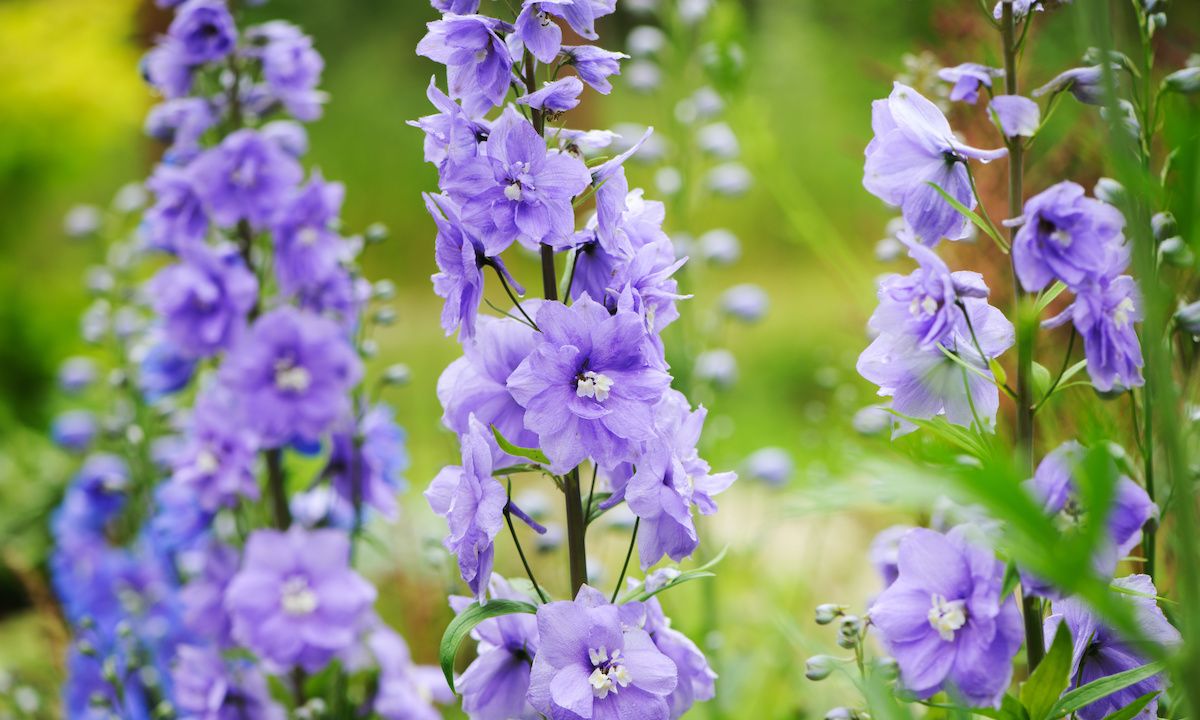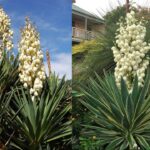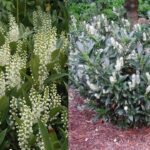Larkspur flowers are a beautiful addition to any garden, known for their vibrant blue, pink, purple, and white blooms. These delicate, tall flowers add an elegant touch to flower beds, cutting gardens, and even containers.
If you’re looking to grow larkspur, this comprehensive guide will provide you with everything you need to know, from planting to care and maintenance.
How to Plant Larkspur?
To plant larkspur, scatter seeds directly into well-draining soil in early spring or fall, as they need cool temperatures to germinate. Press the seeds lightly into the soil without covering them, as they require light to sprout.
Water gently to keep the soil moist until seedlings emerge. Once the plants grow a few inches tall, thin them out to ensure proper spacing for healthy growth and good air circulation.
Timing
Timing is crucial for successfully planting larkspur. These flowers prefer cool weather, so it’s best to plant larkspur seeds in early spring or fall, depending on your local climate. For warmer regions, planting in fall allows the seeds to germinate and grow during cooler temperatures.
- Early Spring: Sow seeds as soon as the soil can be worked.
- Fall: In regions with mild winters, sowing seeds in fall ensures early blooms.
Soil Preparation
Larkspur thrives in well-draining, fertile soil. Prepare the soil by loosening it to a depth of about 12 inches and amending it with compost or well-rotted manure. This improves soil structure and provides essential nutrients.
- Soil pH: Slightly alkaline soil (6.5 to 7.5 pH) is ideal.
- Remove rocks, debris, and weeds to prevent competition for nutrients.
Sowing
Larkspur seeds require cold stratification to germinate effectively. Place seeds in a refrigerator for about 2 weeks before planting. After stratification:
- Scatter seeds on the prepared soil surface.
- Lightly press them into the soil without covering them too deeply.
- Water gently to keep the soil moist.
Watering
Water the seeds lightly but consistently until they germinate, which typically takes 10-14 days. Once the seedlings appear, reduce watering to avoid root rot.
How to Grow Larkspur?
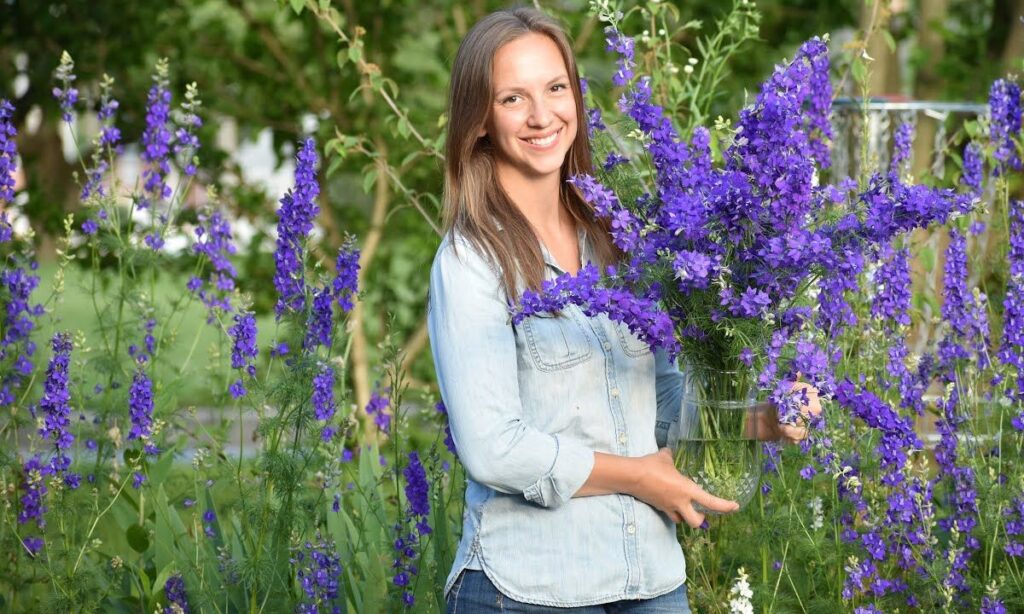
To grow larkspur, start by sowing seeds in cool weather, either in early spring or fall, as they prefer cooler temperatures to germinate. Plant the seeds in well-draining soil and full sun for the best results.
Keep the soil consistently moist but not soggy until seedlings appear. Once established, thin the plants to allow proper air circulation, and watch them thrive with minimal care.
Thinning
To ensure healthy growth, thin the seedlings to about 6-12 inches apart. Proper spacing allows for adequate airflow, reducing the risk of diseases and encouraging stronger plants.
Support
Larkspur plants can grow tall, reaching heights of 3-5 feet. Provide stakes or small trellises to support the plants and prevent them from bending or breaking due to wind.
- Place stakes early to avoid disturbing roots later.
- Use garden twine to gently tie stems to supports.
Mulching
Apply a layer of organic mulch, such as straw or bark chips, around the base of the plants. Mulch helps retain soil moisture, suppress weeds, and regulate soil temperature.
Deadheading
To encourage continuous blooming, regularly deadhead spent flowers. This also prevents the plants from self-seeding excessively, keeping your garden neat and tidy.
Also See This Blog: How to Plant and Grow Dahlias Flowers_2024 Guide
Where to Grow Larkspur
Larkspur grows best in areas with full sun, receiving at least 6 hours of direct light daily. Choose a spot with well-draining soil to prevent waterlogging, as the plant dislikes soggy roots.
These flowers thrive in cooler climates, making them ideal for early spring or fall planting. They also do well in garden beds, borders, or as part of wildflower meadows for a natural, colorful display.
Flower Beds
Larkspur adds vertical interest to flower beds, making them ideal for borders and mixed plantings. Pair larkspur with other mid-height perennials for a colorful display.
Cutting Gardens
Larkspur is a favorite among gardeners who love to create fresh floral arrangements. Its long stems and vibrant blooms make it perfect for cutting gardens.
Cottage Gardens
For a cottage garden aesthetic, plant larkspur alongside classic flowers like foxglove, hollyhocks, and delphiniums. The tall spikes of larkspur create a natural, wild look.
Container Gardens
If space is limited, larkspur can thrive in large containers or pots. Use dwarf varieties for better results, and place the containers in locations that receive full sun.
Care for Larkspur
Larkspur thrives in full sun and requires well-draining soil to prevent waterlogging. Regular watering is essential, but allow the soil to dry slightly between waterings to avoid root rot.
To encourage healthy growth, feed larkspur with a balanced fertilizer during the growing season. Deadhead blooms to promote continuous flowering and prevent the plant from self-seeding excessively.
Soil Requirements
Larkspur prefers fertile, well-draining soil. Poor soil can be improved by adding organic matter such as compost or peat moss. Ensure the soil remains slightly alkaline.
Watering Needs
Water larkspur plants deeply once a week, allowing the soil to dry slightly between waterings. Avoid overwatering, as larkspur roots are susceptible to rot.
Fertilizer Requirements
Feed larkspur with a balanced, slow-release fertilizer at planting time. For continuous growth, apply a diluted liquid fertilizer every 4-6 weeks during the growing season.
- Avoid high-nitrogen fertilizers, as they promote leafy growth at the expense of flowers.
Temperature and Climate Considerations
Larkspur thrives in cool climates with temperatures ranging from 50°F to 75°F. In regions with hot summers, grow larkspur as a fall or winter flower to avoid heat stress.
Potting and Repotting Larkspur
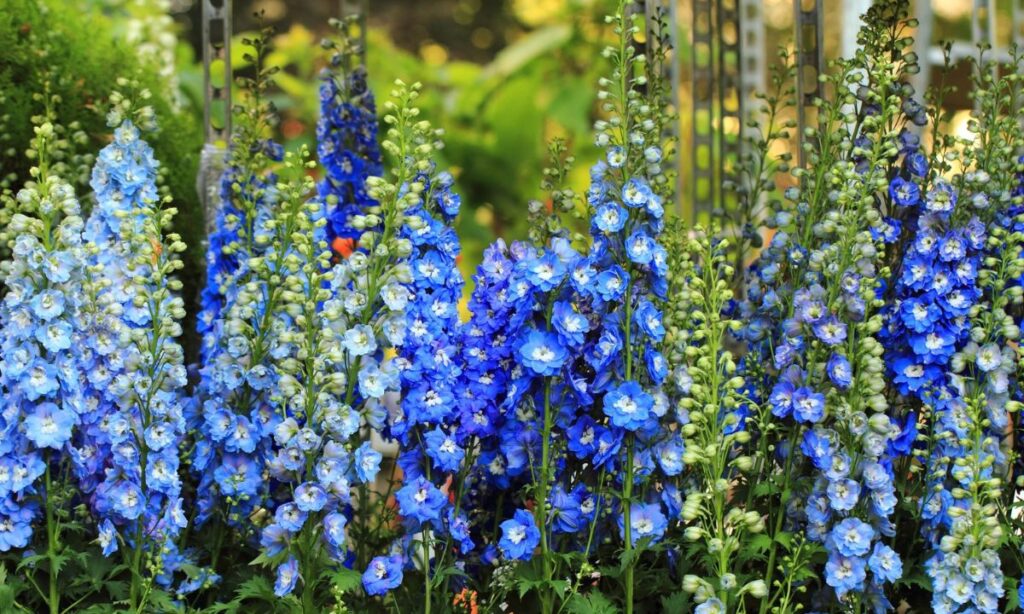
Potting larkspur requires well-draining soil and a container with good drainage holes to prevent root rot. Use a mix of garden soil and compost to provide essential nutrients for healthy growth.
When repotting, choose a slightly larger pot to give the roots more space to spread. Gently transfer the plant, keeping the root ball intact, and water thoroughly to help it settle in its new home.
Container Selection
Choose large, deep containers with drainage holes to accommodate larkspur’s deep root system. A pot with at least 12-15 inches in diameter is ideal for one plant.
Potting Mix
Use a well-draining potting mix enriched with organic matter. A mix of garden soil, compost, and perlite provides the ideal texture and nutrient balance.
Planting
Sow the seeds directly in the container, following the same process as for in-ground planting. Keep the soil moist until germination occurs.
Watering
Water container-grown larkspur regularly but allow the top layer of soil to dry between waterings. Overwatering can lead to root rot.
Fertilizing
Feed potted larkspur with a diluted liquid fertilizer every 4 weeks during the growing season to support healthy blooms.
Repotting
If larkspur outgrows its container, repot it into a larger pot with fresh potting mix. Do this in early spring or fall to minimize transplant stress.
Popular Larkspur Varieties
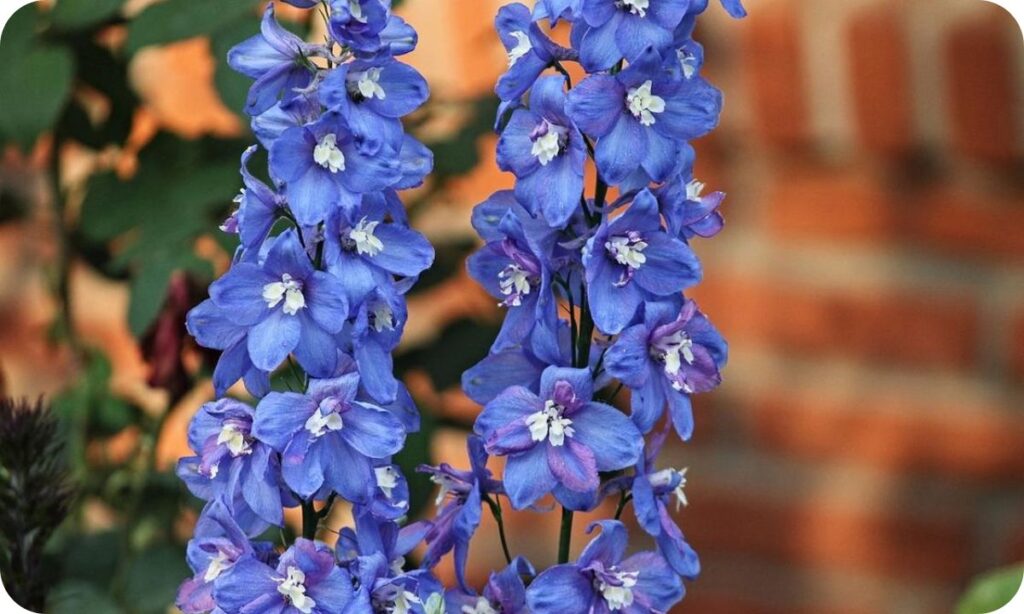
Larkspur flowers are cherished for their tall spikes and vibrant blooms, making them a garden favorite. Popular varieties include the Giant Imperial, known for its rich blue, pink, and white flowers, and the King Arthur, which dazzles with its deep purple petals.
Another standout is the QIS Series, perfect for cutting gardens due to its sturdy stems and vivid colors. For a softer touch, the Cloudy Skies variety offers delicate pastel blooms that add an ethereal charm to any floral arrangement.
1. Larkspur ‘Cloudy Skies Mix’
This variety features a blend of soft blue, lavender, and white blooms, creating a dreamy, cloud-like effect in gardens.
2. Larkspur ‘Imperial Strain Mix’
Known for its tall, sturdy stems and vibrant colors, this mix includes shades of purple, pink, and blue, making it perfect for cutting gardens.
3. Larkspur ‘Sublime Mix’
The ‘Sublime Mix’ offers a stunning variety of rich, jewel-toned flowers that brighten up cottage gardens and floral arrangements.
4. Larkspur ‘Giant Imperial White King’
This variety produces large, pure white blooms on tall stems, adding an elegant touch to any garden.
5. Larkspur ‘Galilee Blue’
With its striking blue flowers, ‘Galilee Blue’ stands out in both flower beds and containers, offering a bold pop of color.
Larkspur Companion Plants
Pair larkspur with these companion plants for a visually stunning garden:
- Foxgloves: Add height and texture.
- Poppies: Provide a bright contrast with their vibrant petals.
- Snapdragons: Complement larkspur’s tall spikes with colorful blooms.
- Delphiniums: Combine for a harmonious blue and purple theme.
- Cosmos: Offer a soft, feathery backdrop to larkspur flowers.
Frequently Asked Questions
How long does it take for larkspur to bloom?
Larkspur typically blooms within 10-12 weeks after sowing, depending on temperature and growing conditions.
Can larkspur grow in pots?
Yes, larkspur can thrive in large containers with proper soil, watering, and support.
Do larkspur flowers reseed themselves?
Larkspur often self-seeds in favorable conditions, providing blooms for the next growing season.
Are larkspur flowers toxic?
Yes, all parts of the larkspur plant are toxic to humans and pets if ingested.
What climate is best for larkspur?
Larkspur grows best in cool climates with mild winters and moderate summers.
Conclusion
Growing larkspur flowers can be a rewarding experience for gardeners of all skill levels. These beautiful, tall blooms are perfect for flower beds, cutting gardens, and containers. By following proper planting techniques, providing the right care, and choosing suitable companion plants, you can enjoy vibrant larkspur blooms throughout the season.
Whether you’re growing larkspur for floral arrangements or to enhance your garden’s beauty, these flowers are sure to impress. With their variety of colors and elegant structure, larkspur brings a touch of charm and sophistication to any garden.

FAtima is a talented content writer and digital marketer with expertise in SEO, social media management, and online marketing.
